Glasses for color blindness: how it works and what the difficulties of selecting
After last year we wrote a short note about the most popular points for color-blind Enkhrom, they knocked on drugs and turned our attention to the fact that apart from these expensive ones, there is also a brand that produces corrective lenses - Pilestone.
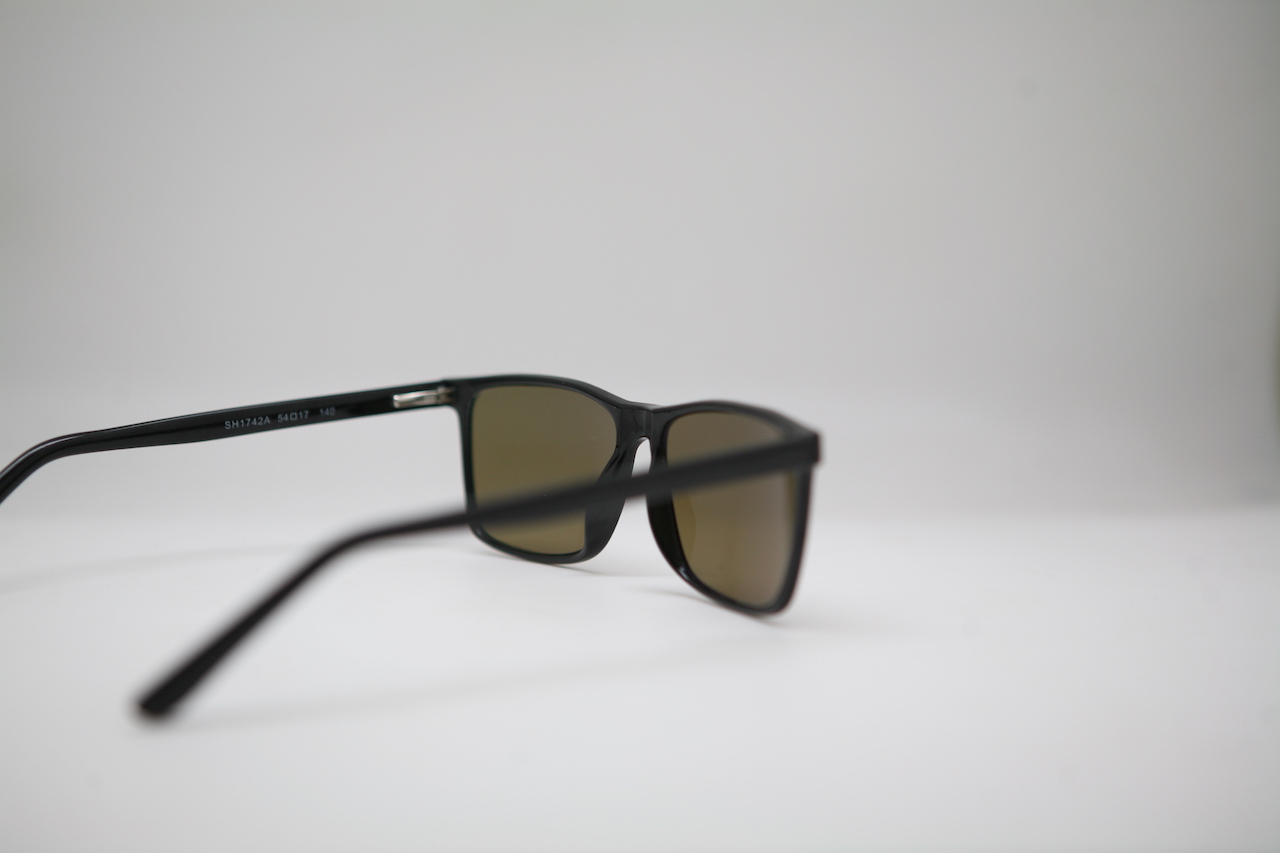
Of course, to write about the problem of color blindness, not having (thank God) an opportunity to thoroughly test the effect of certain lenses, this is not the most grateful thing, but still we have collected some materials. Perhaps you will be interested.
Treatment for color blindness
Color blindness is a genetic disease that is characterized by the nondiscrimination of certain shades. The most frequent case is the non-discrimination of red color, which “renders” yellowness.
Research and experiments aimed at returning “normal” vision to people have been conducted for a long time. One of them, for example, was written on Wired back in 2009 : as part of the experiment, it was possible to return the perception of red and green colors to monkeys.

But where is the person, and where is the monkey ... In fact, our vision is generally imperfect, and we really lose in the perception of colors to some smaller brothers, say, birds, which have 4 color-sensitive cells, whereas we have - 3. A person perceives a wave of color more brain than eye: this applies to all shades, because we see base red / green / blue. And, when it comes, for example, to "blue", then green and blue colors will work, conveying the meaning of "intermediateness" to the brain.
The most unprecedented lag is, by the way, from the praying mantis cancer , which has 16 photoreceptors!

In other words, losing one of the colors for a person is more than critical, therefore the problems of color blindness are quite acute in modern society. Despite the fact that many successfully adapt to their vision in the process of life, to return a person all the colors is a task that modern scientists and physicians are trying to solve.
By the way, some color-blind people are quite calm about their vision, they don’t make a tragedy out of this and don’t get deeply into the problem. I managed to communicate with a couple of people who really do not know what type of vision loss they have, and generally live normally without taking any action. One of them, even after a successful test with one of the frames, said that he did not intend to use glasses in the future.
Glasses and lenses
Perhaps the only way today to adjust the perception of colors - glasses and lenses. And there are a lot of pitfalls here! If you summarize everything that is written on the sites:
And so on and so forth. In other words, even if a person enters the most common group of color blindness with a loss of perception in red, all the same his vision remains purely individual: simply speaking on two color blind, the effect of the same glasses can be completely different!
It is also complicated by the fact that in Russia, for example, optics such as exchange and return are not subject to, that at the cost of, say, Enkhroms (30,000 rubles) strongly repels buyers. In any case, despite the numerous videos of the successful use of glasses for color-blind people, we must remember that: 1. It is better to find an opportunity to try on; 2. Each case is individual!
Enchroma
One of the most popular products in this category is Enchroma glasses.. Points act as a filter that helps to separate the "mixed" colors for better perception:

Under ideal circumstances, the effect of the lenses can be illustrated by this picture.

The points themselves as spectacles are no different.

They are in a very light, plastic frame, almost weightless. The build quality is also difficult to call them super-reliable ...

You can even say that in some places they are casually executed. Glasses have a rectangular shape.

For an ordinary person, the effect of "glasses / no glasses" is not felt. If you try to convey this picture, it turns out that we face a filter that makes the colors brighter.

Here the question would be curious, but as a person for whom a new color suddenly appeared, he recognized it, even after a hint. How did he suddenly realize that red is red, if previously a wave of a given color reached him in a distorted form? Alas, and here - we have, unfortunately, no answer.
Pilestone The
second brand we met thanks to Habr (then Geektimes) - Pilestone . And its competitive advantage is price. As a matter of fact, in the price tag of “Enkhrom” you can fit all the current models of Pilestone, and it’s like one for sure.
It all started like this:

On the one hand, it looked like an advertising review from a landing page, but when it comes to some useful topic, we always try to see this as an opportunity and somehow react to it. The official supplier of Pilestone was found in Russia ...
In fact, we have the following: the brand is represented by several models, and literally until recently they differed, as it were, by the type of correction:
We asked questions to suppliers about this, due to the fact that we have already found out about the individuality of color perception, and the supplier himself eventually removed this classification from the site, and asked us to do similar actions. However, again, you can try to do an experiment with a camera.
Model TP006
These glasses are in the form of aviators.

Supplied in a metal frame.
The lenses have different shades from the outside and the inside:

Initially they were positioned as glasses for patients with protanopia. There are some definite conclusions, how difficult it is to make the "attribution" difficult, but you can take a picture of the monitor through a lens:


Actually the filter seems to be doing its job. It is difficult to say how correct the refusal to classify points according to the types of color correction was, but if you resort to the same method of "checking", then the number of 44 and 56 points did manage, it seems much worse.
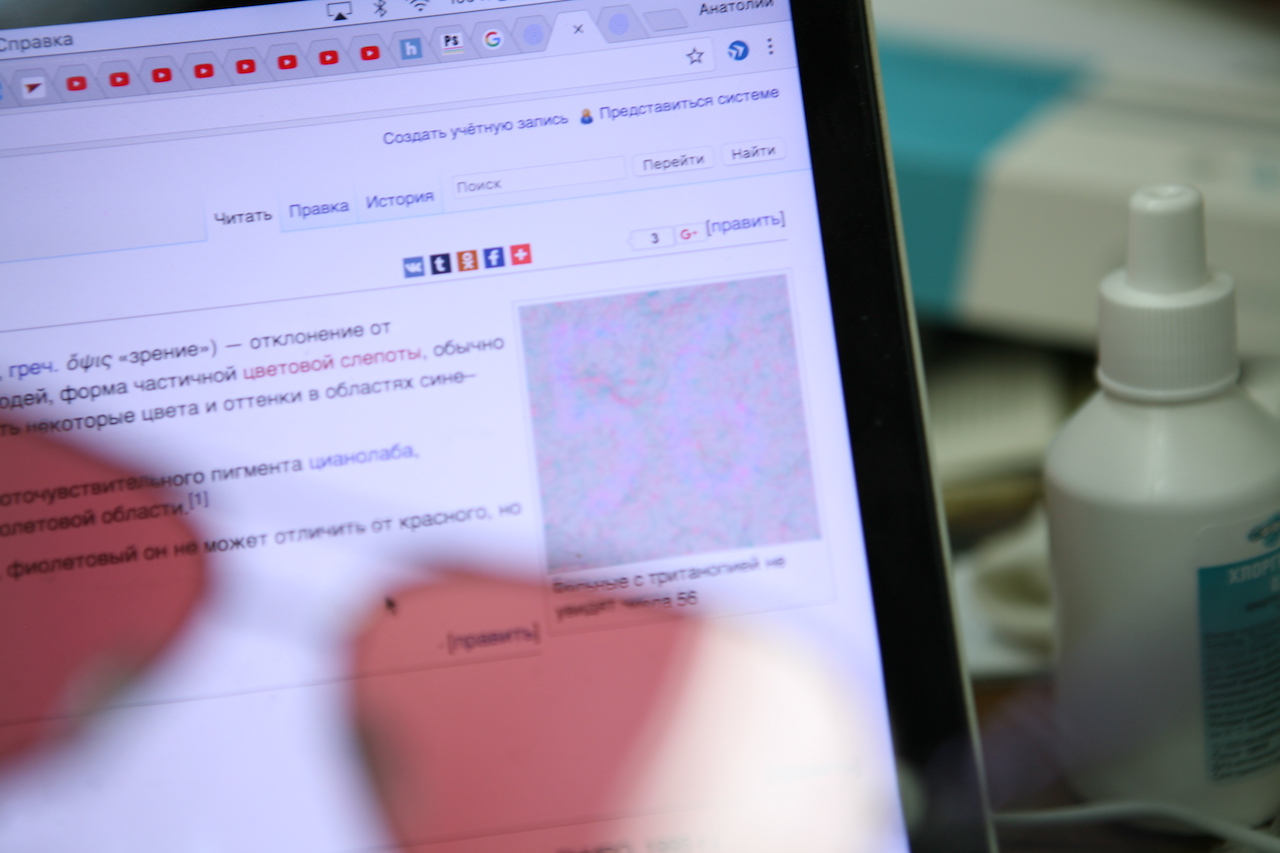



Enkhrom vs Pilestone
If we continue to develop the topic of refusal of detailing, then it turns out that this model and Enchrom should work the same: but this is not so.
Questions about which points are better or worse arise on Western resources. In one of the Reddit branches, you can read that Pilestone glasses do not work at all , and the whole secret is on the back of the lenses, to put it simply in a bright red shade.
In another branch (again pointing to the too-red color of the back side of the lenses), they nevertheless recognize that the red tint has now become distinguishable, but at the same time the red color is also rejected on all surrounding objects.
So, it is necessary, first, to say that the glasses are really photographed in the photo in such a way that the inner side is not visible. Secondly, opinions are still controversial and, finally, it is worth saying that both Pilestone and Enchroma have FDA for their products, which, as it were, gives some authority.
Plus, we compare the brand with the brand, and the Pilestone line includes several models with different types of lenses and different shades, while the Enchrome models differ only in form (except for sun shades). In any case, if we again take Enkhrom as the standard, then one pair of Pilestone points is comparable to them.
Pilestone GM2 These
turned out to be these glasses . They, and it immediately catches the eye, are distinguished by a red tint and outside the lenses:

And inside:

Figures from pictures:



Another model to which you should pay attention - Pilestone TP12 . It is similar to the previous one, but with less bright lenses.

If you use the same technique again, the numbers in the pictures will look like this: a
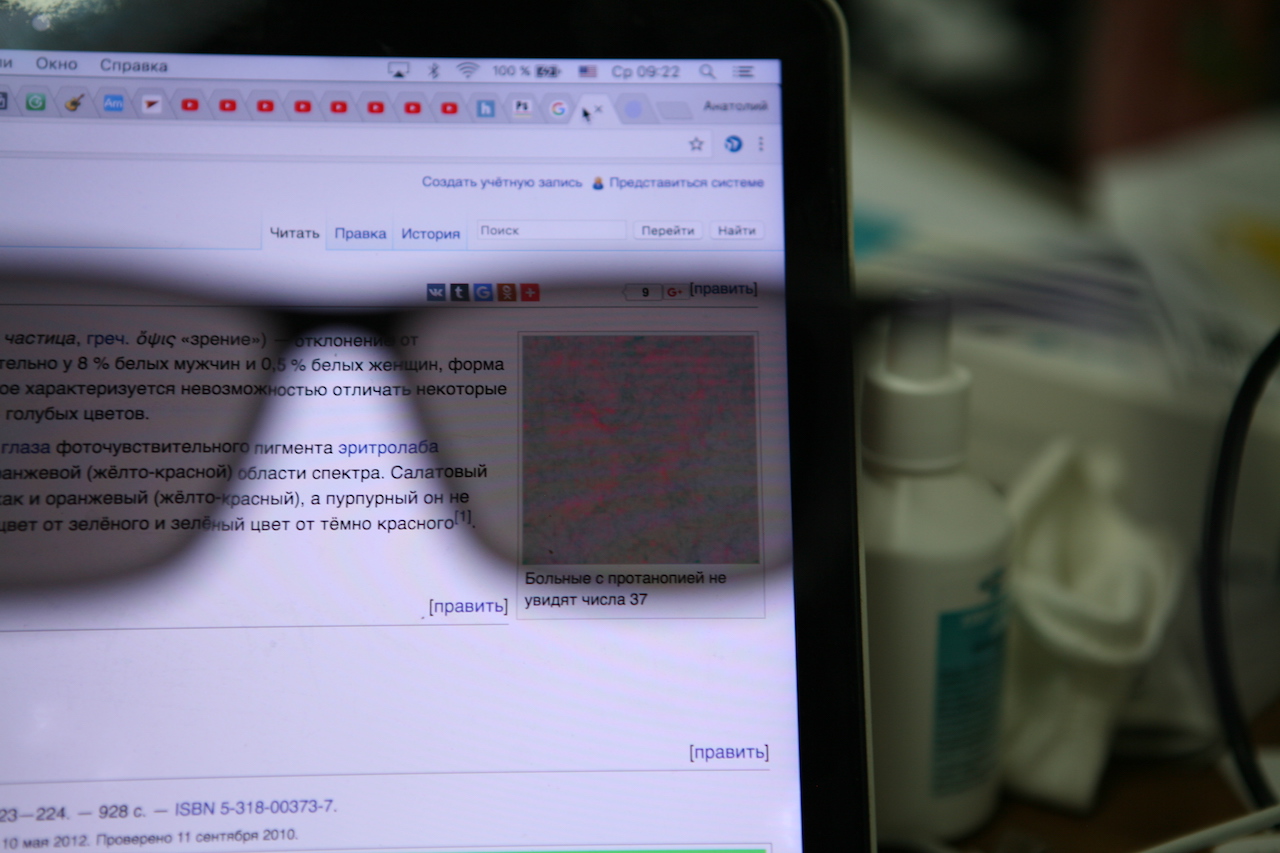


great deception or a great discovery?
It is very difficult for people with ordinary eyesight to understand even from the words, what is happening there, what kind of sensations a person experiences and whether all of this actually works. If the lenses just paint the colors - this is not exactly the effect that I would like to achieve.
Moreover, Enchroma manufacturers position their glasses not as a “dyeing” filter, but as a filter that separates the waves of color, so that each photocell of our body has an equal number of photons.
Of course, comparing it, putting the photographed monitor, is not the best idea, but a healthy person has no other options. By the way, what about Enkhrom?

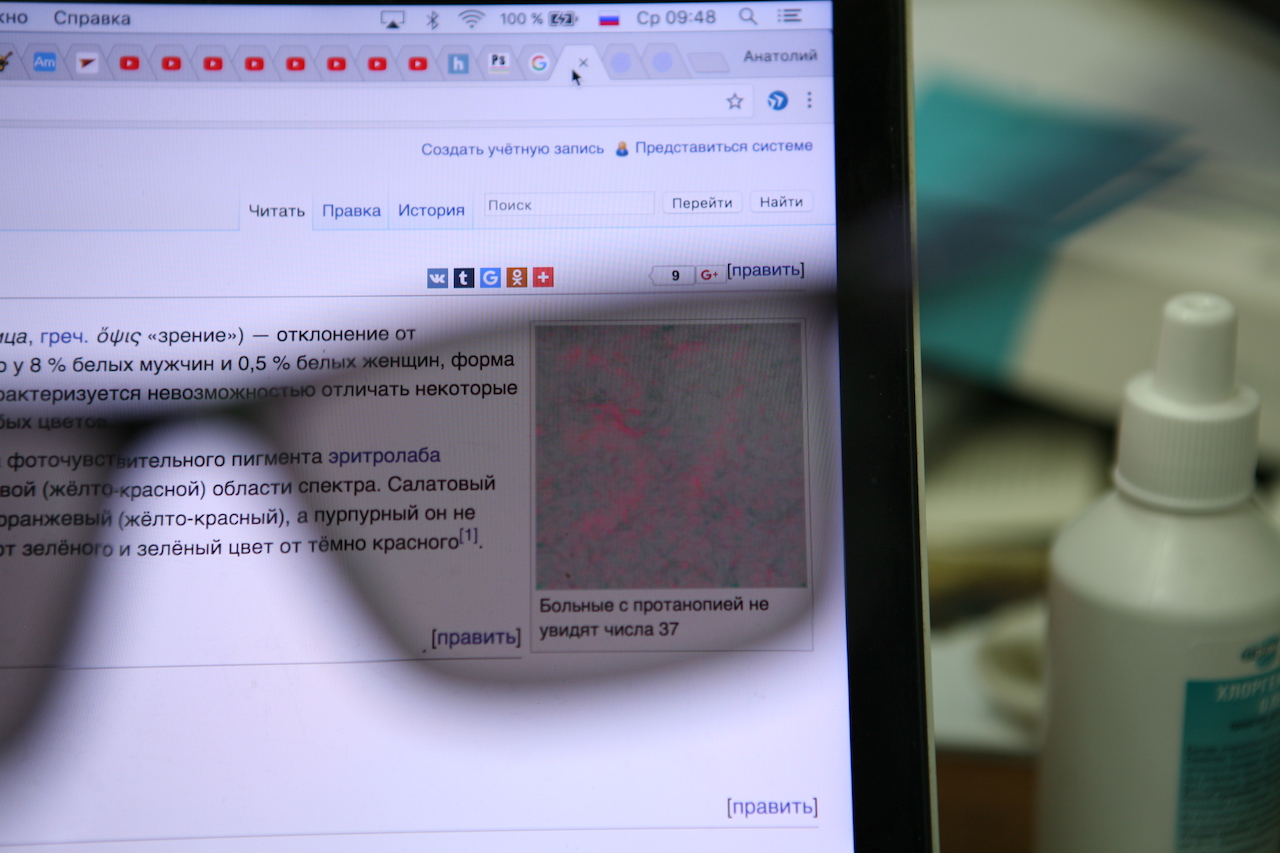

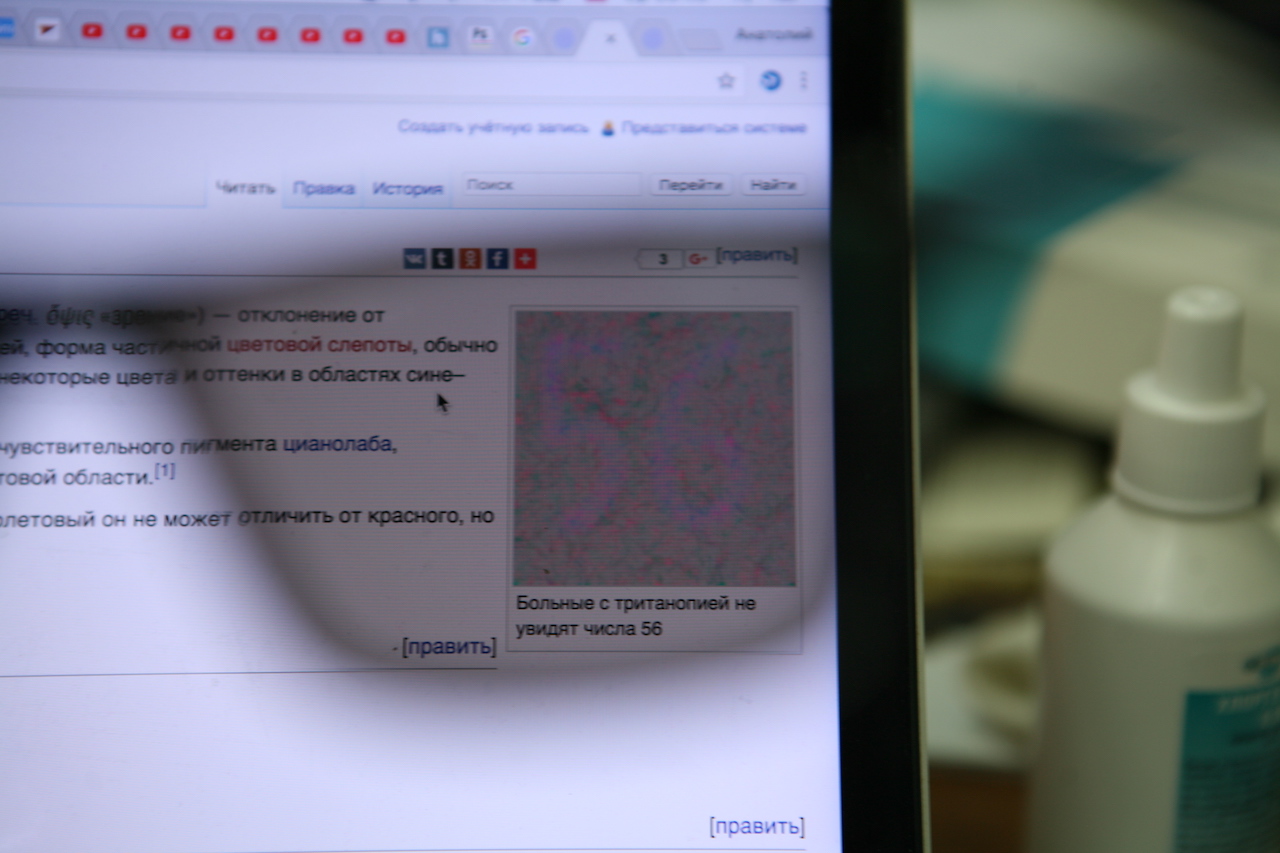


Under relatively equal conditions, some figures from this approximate test show even a slightly worse result than those of the Pilestone models, but the filter seems to work.
If all these glasses are some kind of superfilter, then any sun glasses with polarization should have a similar effect, and, by the way, Persol on the number 56 has a good result ...




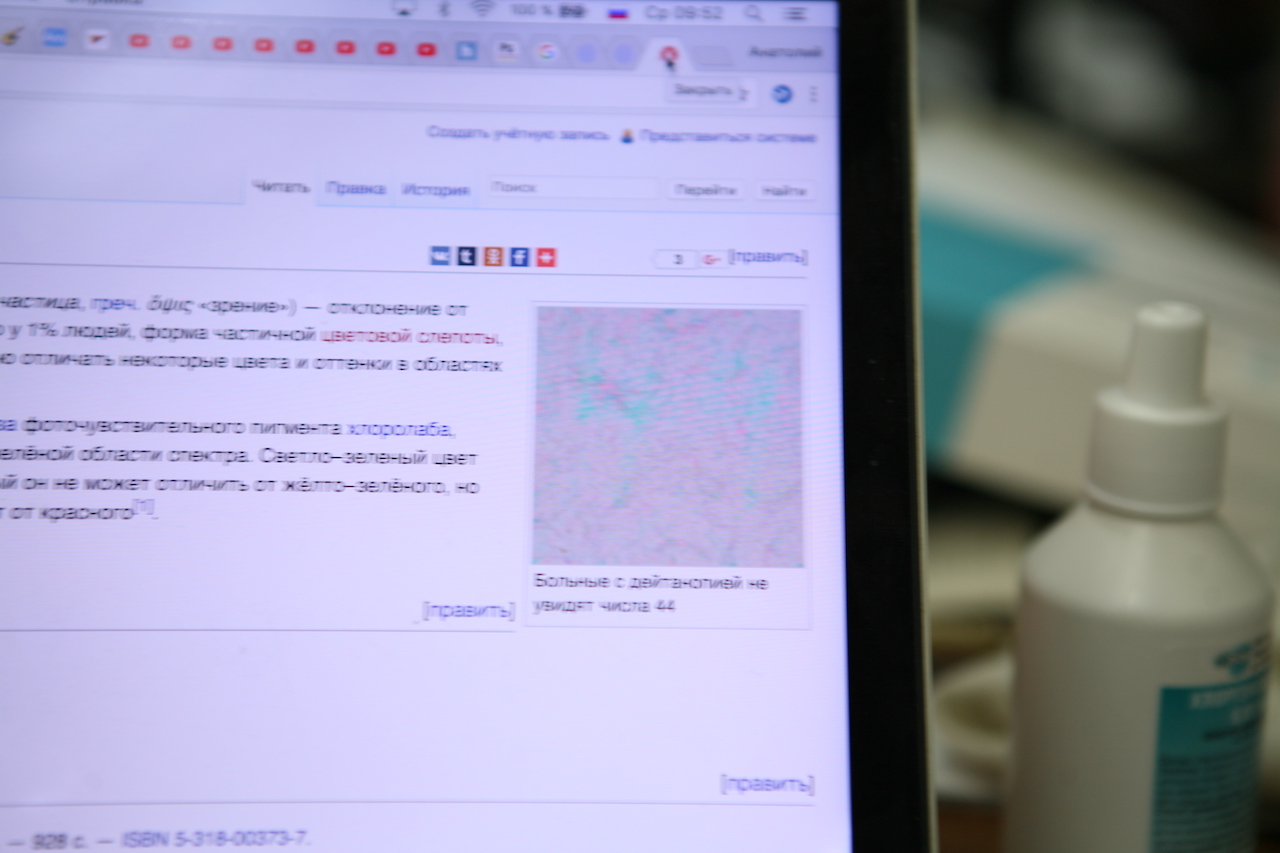

And what is the result?
Of course, we will not undertake to recommend this or that model of glasses. We will not undertake to diagnose or say: this works exactly, and this is not very. Points act as an auxiliary filter - it seems to be understandable, but each model can behave differently on a different nose.
With confidence we can only say:
Also, despite research and scientific experiments, color blindness is still today considered to be incurable, so manufacturers of corrective glasses will still appear for some time, and with the growth of the market one can expect quackery, so you have to be vigilant.
As for the two brands from the article, both are represented in Russia. More details about the models can be found on our website:
In the final - a small test to test vision.

Of course, to write about the problem of color blindness, not having (thank God) an opportunity to thoroughly test the effect of certain lenses, this is not the most grateful thing, but still we have collected some materials. Perhaps you will be interested.
Treatment for color blindness
Color blindness is a genetic disease that is characterized by the nondiscrimination of certain shades. The most frequent case is the non-discrimination of red color, which “renders” yellowness.
Research and experiments aimed at returning “normal” vision to people have been conducted for a long time. One of them, for example, was written on Wired back in 2009 : as part of the experiment, it was possible to return the perception of red and green colors to monkeys.

But where is the person, and where is the monkey ... In fact, our vision is generally imperfect, and we really lose in the perception of colors to some smaller brothers, say, birds, which have 4 color-sensitive cells, whereas we have - 3. A person perceives a wave of color more brain than eye: this applies to all shades, because we see base red / green / blue. And, when it comes, for example, to "blue", then green and blue colors will work, conveying the meaning of "intermediateness" to the brain.
The most unprecedented lag is, by the way, from the praying mantis cancer , which has 16 photoreceptors!

In other words, losing one of the colors for a person is more than critical, therefore the problems of color blindness are quite acute in modern society. Despite the fact that many successfully adapt to their vision in the process of life, to return a person all the colors is a task that modern scientists and physicians are trying to solve.
By the way, some color-blind people are quite calm about their vision, they don’t make a tragedy out of this and don’t get deeply into the problem. I managed to communicate with a couple of people who really do not know what type of vision loss they have, and generally live normally without taking any action. One of them, even after a successful test with one of the frames, said that he did not intend to use glasses in the future.
Glasses and lenses
Perhaps the only way today to adjust the perception of colors - glasses and lenses. And there are a lot of pitfalls here! If you summarize everything that is written on the sites:
- Points are not suitable for everyone, and 10% of users do not see any difference
- Be sure to try on the optics, look, the process of getting used to the glass can take from half an hour to several days
- Some lenses "work" only with natural light, the house is useless
- It may be too "bright" actualization of color + other colors will be painted on the way
And so on and so forth. In other words, even if a person enters the most common group of color blindness with a loss of perception in red, all the same his vision remains purely individual: simply speaking on two color blind, the effect of the same glasses can be completely different!
It is also complicated by the fact that in Russia, for example, optics such as exchange and return are not subject to, that at the cost of, say, Enkhroms (30,000 rubles) strongly repels buyers. In any case, despite the numerous videos of the successful use of glasses for color-blind people, we must remember that: 1. It is better to find an opportunity to try on; 2. Each case is individual!
Enchroma
One of the most popular products in this category is Enchroma glasses.. Points act as a filter that helps to separate the "mixed" colors for better perception:

Under ideal circumstances, the effect of the lenses can be illustrated by this picture.

The points themselves as spectacles are no different.

They are in a very light, plastic frame, almost weightless. The build quality is also difficult to call them super-reliable ...

You can even say that in some places they are casually executed. Glasses have a rectangular shape.

For an ordinary person, the effect of "glasses / no glasses" is not felt. If you try to convey this picture, it turns out that we face a filter that makes the colors brighter.

We gave points to the test for two people. Both of them recognized that the effect of Enkhromy is. Previously mixed colors became distinguishable, they became more visible, that is, they did not cause additional questions. At the same time, we cannot describe the specific sensations about what has changed and how it works.
Here the question would be curious, but as a person for whom a new color suddenly appeared, he recognized it, even after a hint. How did he suddenly realize that red is red, if previously a wave of a given color reached him in a distorted form? Alas, and here - we have, unfortunately, no answer.
Pilestone The
second brand we met thanks to Habr (then Geektimes) - Pilestone . And its competitive advantage is price. As a matter of fact, in the price tag of “Enkhrom” you can fit all the current models of Pilestone, and it’s like one for sure.
It all started like this:

On the one hand, it looked like an advertising review from a landing page, but when it comes to some useful topic, we always try to see this as an opportunity and somehow react to it. The official supplier of Pilestone was found in Russia ...
In fact, we have the following: the brand is represented by several models, and literally until recently they differed, as it were, by the type of correction:
- Protanopia
Deviation from normal color perception occurs in approximately 8% of white men and 0.5% of white women, a form of partial color blindness, usually congenital, which is characterized by the inability to distinguish certain colors and shades in areas of yellow-green, purple-blue colors.
Protanopia is associated with the absence in the cones of the retina of the photosensitive erythrolab pigment with a maximum spectral sensitivity in the orange (yellow-red) spectral region. Lime (yellow-green) color is perceived as sick, as well as orange (yellow-red), and it cannot be distinguished from magenta from blue, but it also distinguishes blue from green and green from dark red.
To date, this defect is incurable.
A source
- Deuteranopia
Deviation from normal color perception is found in approximately 1% of people, a form of partial color blindness, usually congenital, which is characterized by the inability to distinguish certain colors and shades in areas of blue-green, purple-yellow-green colors.
Deuteranopia is associated with the absence in the cones of the retina of the photosensitive pigment chlororuba, which has a maximum spectral sensitivity in the yellow-green region of the spectrum. Light green is perceived as sick, as well as light blue, magenta cannot be distinguished from yellow-green, but at the same time it distinguishes violet from green and green from red.
To date, this defect is incurable.
A source
- Tritanopia
Deviation from normal color perception is extremely rare in humans, a form of partial color blindness, usually congenital, which is characterized by the inability to distinguish certain colors and shades in areas of blue – yellow, violet – red colors.
Tritanopia is associated with the absence in the rods of the retina of the photosensitive cyanolab pigment, which has a maximum spectral sensitivity in the blue-violet region.
Yellow color is perceived by tritanop, just like blue, violet, it cannot be distinguished from red, but it also distinguishes purple from green.
To date, this defect is incurable.
A source
We asked questions to suppliers about this, due to the fact that we have already found out about the individuality of color perception, and the supplier himself eventually removed this classification from the site, and asked us to do similar actions. However, again, you can try to do an experiment with a camera.
Model TP006
These glasses are in the form of aviators.

Supplied in a metal frame.
The lenses have different shades from the outside and the inside:

Initially they were positioned as glasses for patients with protanopia. There are some definite conclusions, how difficult it is to make the "attribution" difficult, but you can take a picture of the monitor through a lens:


Actually the filter seems to be doing its job. It is difficult to say how correct the refusal to classify points according to the types of color correction was, but if you resort to the same method of "checking", then the number of 44 and 56 points did manage, it seems much worse.




Enkhrom vs Pilestone
If we continue to develop the topic of refusal of detailing, then it turns out that this model and Enchrom should work the same: but this is not so.
We offered the same glasses for comparison to the same person, and if the sensations from Enchroms were unequivocal, then the TP006 model did not show itself at all.
Questions about which points are better or worse arise on Western resources. In one of the Reddit branches, you can read that Pilestone glasses do not work at all , and the whole secret is on the back of the lenses, to put it simply in a bright red shade.
In another branch (again pointing to the too-red color of the back side of the lenses), they nevertheless recognize that the red tint has now become distinguishable, but at the same time the red color is also rejected on all surrounding objects.
So, it is necessary, first, to say that the glasses are really photographed in the photo in such a way that the inner side is not visible. Secondly, opinions are still controversial and, finally, it is worth saying that both Pilestone and Enchroma have FDA for their products, which, as it were, gives some authority.
Plus, we compare the brand with the brand, and the Pilestone line includes several models with different types of lenses and different shades, while the Enchrome models differ only in form (except for sun shades). In any case, if we again take Enkhrom as the standard, then one pair of Pilestone points is comparable to them.
Pilestone GM2 These
turned out to be these glasses . They, and it immediately catches the eye, are distinguished by a red tint and outside the lenses:

And inside:

According to the person who tested this model in comparison with Enchrome, it was possible to understand that the problematic colors became more distinguishable, but much brighter + had a similar effect, as was described on Reddit: everything around got an additional reddish tint. Admittedly, the colors through the Enchrome lenses were softer, more natural, as far as a person with a deviation can understand "naturalness." The GM2 model loses in naturalness despite the fact that it actualizes the necessary shades.
Figures from pictures:



Another model to which you should pay attention - Pilestone TP12 . It is similar to the previous one, but with less bright lenses.

If you use the same technique again, the numbers in the pictures will look like this: a



great deception or a great discovery?
It is very difficult for people with ordinary eyesight to understand even from the words, what is happening there, what kind of sensations a person experiences and whether all of this actually works. If the lenses just paint the colors - this is not exactly the effect that I would like to achieve.
Moreover, Enchroma manufacturers position their glasses not as a “dyeing” filter, but as a filter that separates the waves of color, so that each photocell of our body has an equal number of photons.
Of course, comparing it, putting the photographed monitor, is not the best idea, but a healthy person has no other options. By the way, what about Enkhrom?






Under relatively equal conditions, some figures from this approximate test show even a slightly worse result than those of the Pilestone models, but the filter seems to work.
If all these glasses are some kind of superfilter, then any sun glasses with polarization should have a similar effect, and, by the way, Persol on the number 56 has a good result ...






And what is the result?
Of course, we will not undertake to recommend this or that model of glasses. We will not undertake to diagnose or say: this works exactly, and this is not very. Points act as an auxiliary filter - it seems to be understandable, but each model can behave differently on a different nose.
With confidence we can only say:
- To date, the number of vision-correcting projects has increased
- The most famous, popular, reputable brand - "Enchrom"
- It can be opposed to less famous projects with a much more affordable price tag.
Also, despite research and scientific experiments, color blindness is still today considered to be incurable, so manufacturers of corrective glasses will still appear for some time, and with the growth of the market one can expect quackery, so you have to be vigilant.
As for the two brands from the article, both are represented in Russia. More details about the models can be found on our website:
In the final - a small test to test vision.
